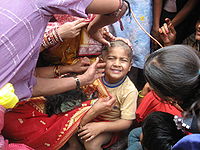Culture Of Deo
Post By :- Rajeev Deo
Email id :- deosamaj@googlegroups.com
Email id :- deo.society@groups.facebook.com
Website :- http://www.deosamaj.blogspot.com/
Website :- http://www.deosociety.blogspot.com/
Website :- http://groups.google.com/group/deosamaj
Maithili, an Eastern Indic language, is spoken in Mithila. Maithili has previously been considered a dialect of both Hindi and Bengali. Today Maithili, is recognized in the Eighth Schedule of Indian official languages. Maithili sounds sweet and soft to outsiders, who often cannot tell whether an argument is taking place. In southern districts of Mithila Angika is spoken.
The Mithila region is rich with culture and traditions. People respect their parents, believe in peaceful life and have a strong belief in God. They worship the goddess of Power Durga. Every home of Mithila has own God or Goddess named Kuldevta. They generally live in larger families. The Hindu festivals are widely celebrated : Makar Sankranti(14 January), Basant Panchami, Shivratri.Holi, Ram Navami, New Year(Mesha Sankranti on 14 April usually, Janaki Navami(Baishakh Shukla 9), Batsavitri, Madhushravani, Nagpanchami, Rakshabandhan,Krishna Janmashtami,Chauth Chandra, Durga Puja, Kojagara(Sharad Purnima), Diwali, Bhatridwitiya, Chhathi, Akshya Navami, Devotthan Ekadashi, Sama Chakeba,Kartik Purnima, Vivaha Panchami,etc. in which some are specific in Mithila e.g.Chauth Chandra when Ganesh Chaturthi in Bhadrapad is celebrated rest of India) and Indra Puja in Ashwin Krishna Paksha and So Bhatridwitiya and Sama Chakeba in Kartik Shuklapaksha-are festivals for brothers and sisters apart from Rakhabandhan as in other parts of Indian subcontinent.
A Mundan ceremony in Mithila.
The Mundan ceremony is a very popular tradition in Mithila. A child's hair is shaved for the first time, accompanied by bhoj (a party) and (sometimes extravagant) celebrations.
The Maithili marriage traditions are important to the people and unique to the region. The custom includes four days of marriage ceremonies called: Barsait,Chautrthi, Madhushravni, Kojagara, and finally Dwiragman (the first homecoming of the bride). The marriage is traditionally fixed using complex genealogical tables, called Panji among Brahmins, “Deo-Chaudhary “ Deo and Karna Kayasthas which are maintained by Panjikars, a special group of Brahmins who prevent marriages among relatives up to sixth degree in Matripaksha and seventh in Pitripakksha.
The name Mithila is also used to refer to a style of Hindu art, Madhubani art, created in the Mithila area. This art originated as ritual geometric and symbolic decorations on the walls and floors of a house, generally done by women before a marriage. The custom was not known to many outside the region. After paper was brought to the area, women began to sell their artwork and expand their subjects to popular and local Hindu deities as well as to the depiction of everyday events. Ganga Devi is perhaps the most famous Mithila artist; her work includes traditional ritual Mithila decorations, depictions of popular deities, scenes from the Ramayana, and events in her own life.
Folk stories A small film industry also exists. Of the many movies produced in Mailthili, "Sasta Jingi Mahag Senoor" and "Mamta Gabe Geet" are perhaps the best known.Off late " Sindurdan " also collected accolades. Among the documentary films that best presents the unparalleled cultural richness of Mithila are "The Cultural Heritage of Mithila" which showcases Pamaria, Pachania, Bhaant, Panaji-Prabandh, Sama-Chakeva, Salhes naach and Salhes gaatha gaayan, Kamla-Pooja etc. and "Mithila Paintings" which showcases the insights into the past, present and emerging forms of the Mithila Paintings.
Maithili (মৈথিলী Maithilī) is a language spoken in the eastern part of India, mainly in the Indian state of Bihar, and in the eastern Terai region of Nepal.[1]
It is an offshoot of the Indo-Aryan languages, which are part of the Indo-Iranian, a branch of the Indo-European languages. Linguists consider Maithili to be an Eastern Indic language, and thus a different language from Hindi, which is Central Indic in origin. According to the 2001 census in India, 12,179,122 people speak Maithili, but various organizations have strongly argued that the actual number of Maithili speakers is much higher than the official data suggests. SIL estimates it to be more than 35 Million. In 2003, Maithili was included in the Eighth Schedule of the Indian Constitution, which now allows the language to be used in education, government, and other official contexts. Maithili has a very rich literary and cultural heritage.
Maithili was traditionally written in the Maithili script (also known by the names Tirhuta and Mithilakshar) and Kaithi script. Nowadays, Devanagari script is most commonly used. An effort is underway to preserve the Maithili script and to develop it for use in digital media by encoding the script in the Unicode standard, for which proposals have been submitted.[2]
The term Maithili comes from Mithila, which was an independent state in ancient times. Mithila has a very important place in Hindu mythology, since it is regarded as the birth place of Goddess Sita, the daughter of King Janak of Mithila; who eventually gets married to Lord Rama.
The most famous literary figure in Maithili is the poet Vidyapati. He is credited for raising the importance of 'people's language', i.e. Maithili, in the official work of the state by influencing the Maharaja of Darbhanga with the quality of his poetry. The state's official language used to be Sanskrit, which distanced common people from the state and its functions. The name Maithili is also one of the names of Sita, the consort of Rama.
\ |
The name Maithili is derived from the word Mithila, an ancient kingdom of which King Janaka was the ruler (See Ramayana). Maithili is also one of the names of Sita, the wife of King Rama and daughter of King Janaka.
It is a fact that scholars in Mithila used Sanskrit for their literary work and Maithili was the language of the common folk (Abahatta). The earliest work in Maithili appears to be Varna(n) Ratnakar by Jyotirishwar Thakur dated about 1324
Post By :- Rajeev Deo
Email id :- deosamaj@googlegroups.com
Email id :- deo.society@groups.facebook.com
Website :- http://www.deosamaj.blogspot.com/
Website :- http://www.deosociety.blogspot.com/
Website :- http://groups.google.com/group/deosamaj
